Sergiu Oprea
InteractAvatar: Modeling Hand-Face Interaction in Photorealistic Avatars with Deformable Gaussians
Apr 10, 2025Abstract:With the rising interest from the community in digital avatars coupled with the importance of expressions and gestures in communication, modeling natural avatar behavior remains an important challenge across many industries such as teleconferencing, gaming, and AR/VR. Human hands are the primary tool for interacting with the environment and essential for realistic human behavior modeling, yet existing 3D hand and head avatar models often overlook the crucial aspect of hand-body interactions, such as between hand and face. We present InteracttAvatar, the first model to faithfully capture the photorealistic appearance of dynamic hand and non-rigid hand-face interactions. Our novel Dynamic Gaussian Hand model, combining template model and 3D Gaussian Splatting as well as a dynamic refinement module, captures pose-dependent change, e.g. the fine wrinkles and complex shadows that occur during articulation. Importantly, our hand-face interaction module models the subtle geometry and appearance dynamics that underlie common gestures. Through experiments of novel view synthesis, self reenactment and cross-identity reenactment, we demonstrate that InteracttAvatar can reconstruct hand and hand-face interactions from monocular or multiview videos with high-fidelity details and be animated with novel poses.
UnrealROX+: An Improved Tool for Acquiring Synthetic Data from Virtual 3D Environments
Apr 23, 2021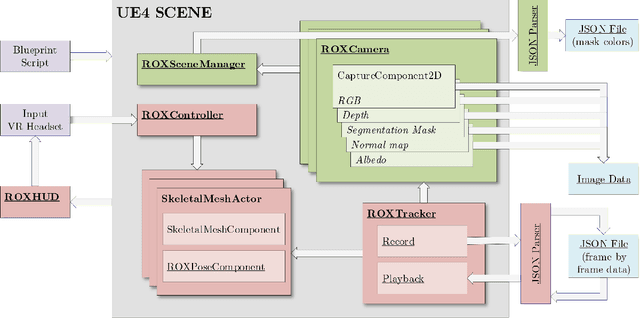

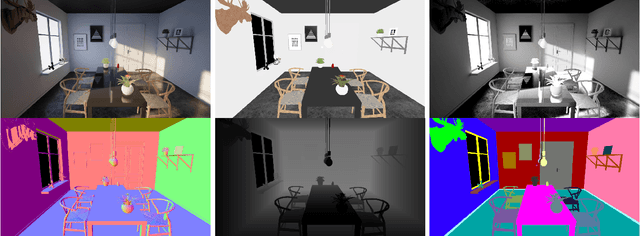
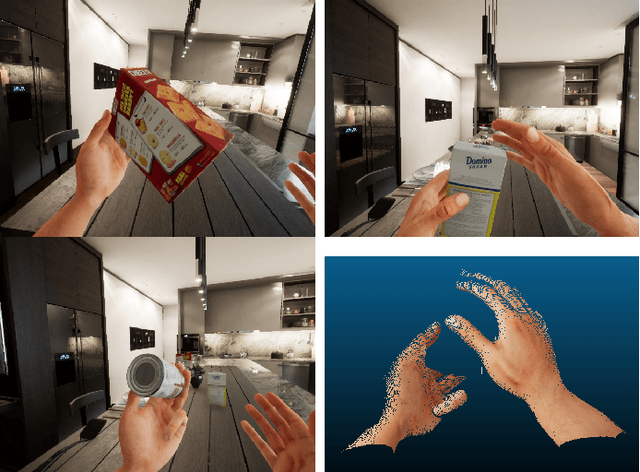
Abstract:Synthetic data generation has become essential in last years for feeding data-driven algorithms, which surpassed traditional techniques performance in almost every computer vision problem. Gathering and labelling the amount of data needed for these data-hungry models in the real world may become unfeasible and error-prone, while synthetic data give us the possibility of generating huge amounts of data with pixel-perfect annotations. However, most synthetic datasets lack from enough realism in their rendered images. In that context UnrealROX generation tool was presented in 2019, allowing to generate highly realistic data, at high resolutions and framerates, with an efficient pipeline based on Unreal Engine, a cutting-edge videogame engine. UnrealROX enabled robotic vision researchers to generate realistic and visually plausible data with full ground truth for a wide variety of problems such as class and instance semantic segmentation, object detection, depth estimation, visual grasping, and navigation. Nevertheless, its workflow was very tied to generate image sequences from a robotic on-board camera, making hard to generate data for other purposes. In this work, we present UnrealROX+, an improved version of UnrealROX where its decoupled and easy-to-use data acquisition system allows to quickly design and generate data in a much more flexible and customizable way. Moreover, it is packaged as an Unreal plug-in, which makes it more comfortable to use with already existing Unreal projects, and it also includes new features such as generating albedo or a Python API for interacting with the virtual environment from Deep Learning frameworks.
H-GAN: the power of GANs in your Hands
Apr 21, 2021
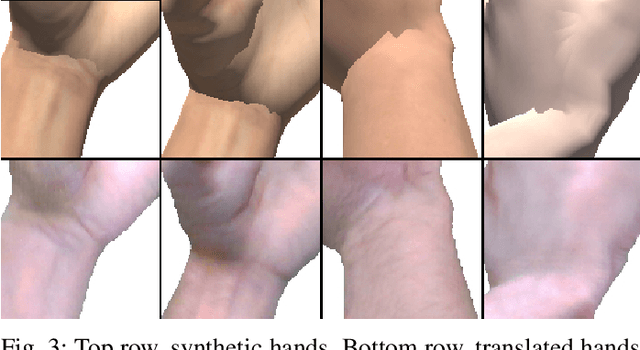
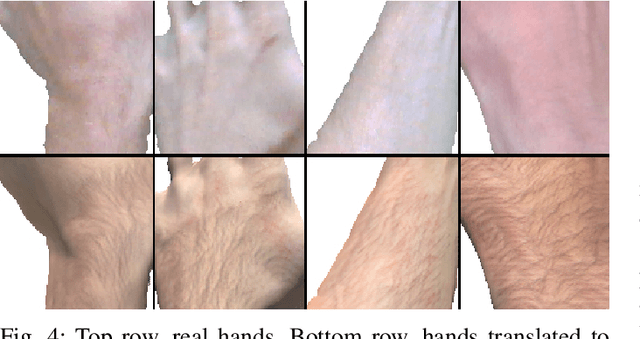
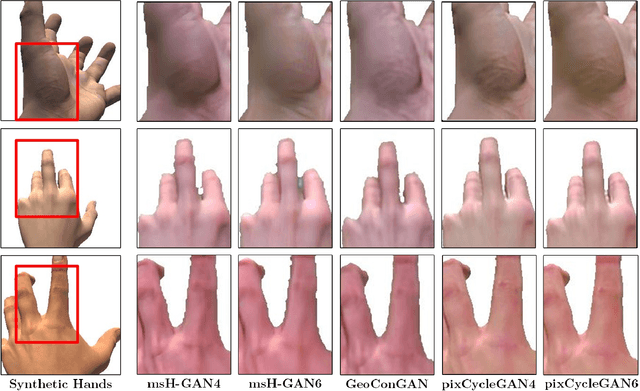
Abstract:We present HandGAN (H-GAN), a cycle-consistent adversarial learning approach implementing multi-scale perceptual discriminators. It is designed to translate synthetic images of hands to the real domain. Synthetic hands provide complete ground-truth annotations, yet they are not representative of the target distribution of real-world data. We strive to provide the perfect blend of a realistic hand appearance with synthetic annotations. Relying on image-to-image translation, we improve the appearance of synthetic hands to approximate the statistical distribution underlying a collection of real images of hands. H-GAN tackles not only the cross-domain tone mapping but also structural differences in localized areas such as shading discontinuities. Results are evaluated on a qualitative and quantitative basis improving previous works. Furthermore, we relied on the hand classification task to claim our generated hands are statistically similar to the real domain of hands.
A Review on Deep Learning Techniques for Video Prediction
Apr 15, 2020



Abstract:The ability to predict, anticipate and reason about future outcomes is a key component of intelligent decision-making systems. In light of the success of deep learning in computer vision, deep-learning-based video prediction emerged as a promising research direction. Defined as a self-supervised learning task, video prediction represents a suitable framework for representation learning, as it demonstrated potential capabilities for extracting meaningful representations of the underlying patterns in natural videos. Motivated by the increasing interest in this task, we provide a review on the deep learning methods for prediction in video sequences. We firstly define the video prediction fundamentals, as well as mandatory background concepts and the most used datasets. Next, we carefully analyze existing video prediction models organized according to a proposed taxonomy, highlighting their contributions and their significance in the field. The summary of the datasets and methods is accompanied with experimental results that facilitate the assessment of the state of the art on a quantitative basis. The paper is summarized by drawing some general conclusions, identifying open research challenges and by pointing out future research directions.
When Deep Learning Meets Data Alignment: A Review on Deep Registration Networks
Mar 06, 2020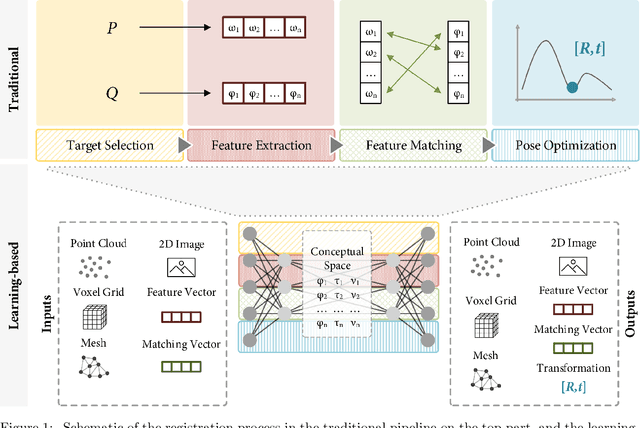

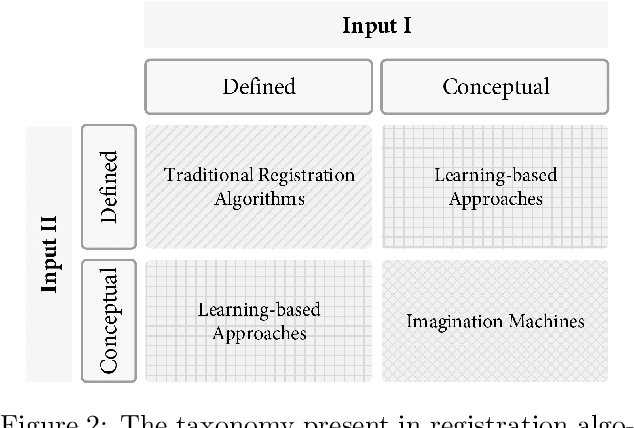

Abstract:Registration is the process that computes the transformation that aligns sets of data. Commonly, a registration process can be divided into four main steps: target selection, feature extraction, feature matching, and transform computation for the alignment. The accuracy of the result depends on multiple factors, the most significant are the quantity of input data, the presence of noise, outliers and occlusions, the quality of the extracted features, real-time requirements and the type of transformation, especially those ones defined by multiple parameters, like non-rigid deformations. Recent advancements in machine learning could be a turning point in these issues, particularly with the development of deep learning (DL) techniques, which are helping to improve multiple computer vision problems through an abstract understanding of the input data. In this paper, a review of deep learning-based registration methods is presented. We classify the different papers proposing a framework extracted from the traditional registration pipeline to analyse the new learning-based proposal strengths. Deep Registration Networks (DRNs) try to solve the alignment task either replacing part of the traditional pipeline with a network or fully solving the registration problem. The main conclusions extracted are, on the one hand, 1) learning-based registration techniques cannot always be clearly classified in the traditional pipeline. 2) These approaches allow more complex inputs like conceptual models as well as the traditional 3D datasets. 3) In spite of the generality of learning, the current proposals are still ad hoc solutions. Finally, 4) this is a young topic that still requires a large effort to reach general solutions able to cope with the problems that affect traditional approaches.
A Visually Plausible Grasping System for Object Manipulation and Interaction in Virtual Reality Environments
Mar 12, 2019



Abstract:Interaction in virtual reality (VR) environments is essential to achieve a pleasant and immersive experience. Most of the currently existing VR applications, lack of robust object grasping and manipulation, which are the cornerstone of interactive systems. Therefore, we propose a realistic, flexible and robust grasping system that enables rich and real-time interactions in virtual environments. It is visually realistic because it is completely user-controlled, flexible because it can be used for different hand configurations, and robust because it allows the manipulation of objects regardless their geometry, i.e. hand is automatically fitted to the object shape. In order to validate our proposal, an exhaustive qualitative and quantitative performance analysis has been carried out. On the one hand, qualitative evaluation was used in the assessment of the abstract aspects such as: hand movement realism, interaction realism and motor control. On the other hand, for the quantitative evaluation a novel error metric has been proposed to visually analyze the performed grips. This metric is based on the computation of the distance from the finger phalanges to the nearest contact point on the object surface. These contact points can be used with different application purposes, mainly in the field of robotics. As a conclusion, system evaluation reports a similar performance between users with previous experience in virtual reality applications and inexperienced users, referring to a steep learning curve.
The RobotriX: An eXtremely Photorealistic and Very-Large-Scale Indoor Dataset of Sequences with Robot Trajectories and Interactions
Jan 19, 2019



Abstract:Enter the RobotriX, an extremely photorealistic indoor dataset designed to enable the application of deep learning techniques to a wide variety of robotic vision problems. The RobotriX consists of hyperrealistic indoor scenes which are explored by robot agents which also interact with objects in a visually realistic manner in that simulated world. Photorealistic scenes and robots are rendered by Unreal Engine into a virtual reality headset which captures gaze so that a human operator can move the robot and use controllers for the robotic hands; scene information is dumped on a per-frame basis so that it can be reproduced offline to generate raw data and ground truth labels. By taking this approach, we were able to generate a dataset of 38 semantic classes totaling 8M stills recorded at +60 frames per second with full HD resolution. For each frame, RGB-D and 3D information is provided with full annotations in both spaces. Thanks to the high quality and quantity of both raw information and annotations, the RobotriX will serve as a new milestone for investigating 2D and 3D robotic vision tasks with large-scale data-driven techniques.
UnrealROX: An eXtremely Photorealistic Virtual Reality Environment for Robotics Simulations and Synthetic Data Generation
Oct 16, 2018



Abstract:Data-driven algorithms have surpassed traditional techniques in almost every aspect in robotic vision problems. Such algorithms need vast amounts of quality data to be able to work properly after their training process. Gathering and annotating that sheer amount of data in the real world is a time-consuming and error-prone task. Those problems limit scale and quality. Synthetic data generation has become increasingly popular since it is faster to generate and automatic to annotate. However, most of the current datasets and environments lack realism, interactions, and details from the real world. UnrealROX is an environment built over Unreal Engine 4 which aims to reduce that reality gap by leveraging hyperrealistic indoor scenes that are explored by robot agents which also interact with objects in a visually realistic manner in that simulated world. Photorealistic scenes and robots are rendered by Unreal Engine into a virtual reality headset which captures gaze so that a human operator can move the robot and use controllers for the robotic hands; scene information is dumped on a per-frame basis so that it can be reproduced offline to generate raw data and ground truth annotations. This virtual reality environment enables robotic vision researchers to generate realistic and visually plausible data with full ground truth for a wide variety of problems such as class and instance semantic segmentation, object detection, depth estimation, visual grasping, and navigation.
A Review on Deep Learning Techniques Applied to Semantic Segmentation
Apr 22, 2017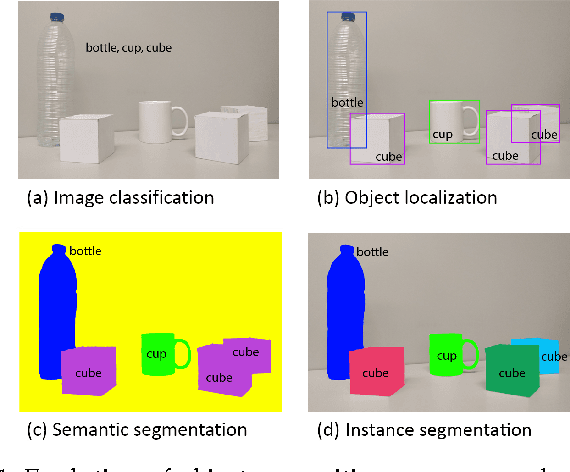
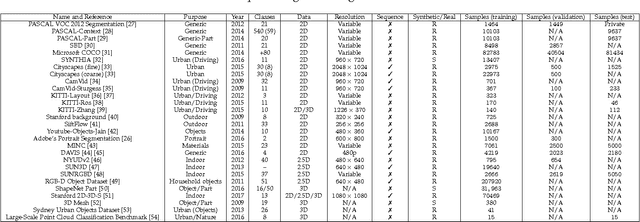


Abstract:Image semantic segmentation is more and more being of interest for computer vision and machine learning researchers. Many applications on the rise need accurate and efficient segmentation mechanisms: autonomous driving, indoor navigation, and even virtual or augmented reality systems to name a few. This demand coincides with the rise of deep learning approaches in almost every field or application target related to computer vision, including semantic segmentation or scene understanding. This paper provides a review on deep learning methods for semantic segmentation applied to various application areas. Firstly, we describe the terminology of this field as well as mandatory background concepts. Next, the main datasets and challenges are exposed to help researchers decide which are the ones that best suit their needs and their targets. Then, existing methods are reviewed, highlighting their contributions and their significance in the field. Finally, quantitative results are given for the described methods and the datasets in which they were evaluated, following up with a discussion of the results. At last, we point out a set of promising future works and draw our own conclusions about the state of the art of semantic segmentation using deep learning techniques.
 Add to Chrome
Add to Chrome Add to Firefox
Add to Firefox Add to Edge
Add to Edge